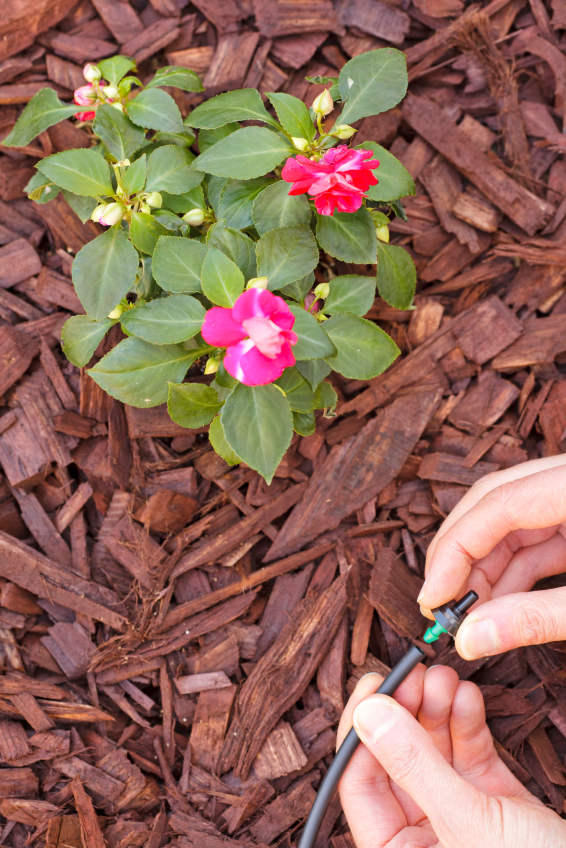Install Efficient Irrigation
Did you know, watering with sprinklers or a hose often uses way more water than you really need to keep your garden healthy and thriving? The solution - drip irrigation! Drip irrigation uses up to 50% less water than most sprinkler systems and brings the water directly to the roots of your plants - which is where they need it the most. Drip irrigation is a system of small tubing and nozzles that you can attach to an outdoor hose or faucet. It can work for most, if not all, water uses, even lawns! Drip systems are low cost, easy to set up and you can often do the install yourself. A great weekend project that saves water and money!
Your Impact
Action Steps & Tips
Introduction
Watering with sprinklers or a hose often uses way more water than you really need to keep your garden healthy and thriving. The best way to irrigate is to add water directly to the roots of your plants and only as much as they need. Drip irrigation was built for this!
Drip irrigation is a system of small tubing and emitters (small nozzles) that easily bring the water directly to the roots of your plants. Drip systems are low cost, easy to set up and you can often do the install yourself. You attach a drip system to an outdoor hose or faucet and it can work for most, if not all, water uses, even lawns!
Plants and trees are healthiest when they are not overwatered. Drip irrigation:
-
Is low cost and easy to install
-
Saves precious water resources and money
-
Can make your plants healthier and more resilient
1Zone your garden and design your drip system
Drip irrigation is easy to set up. Just put the small tubing around your garden and place the emitters (small nozzles) in the tubing right near your plants. Drip irrigation is like putting mini-sprinklers all over your yard. Drip irrigation works for all types of plants including trees, shrubs, plants, vegetables, potted plants, and lawn. It also works well on slopes or uneven surfaces. The first step is planning out your system.
Zone your garden. If you are starting a new garden or adding plants, place plants with the same water and light needs in the same area or “zones”. Plants with similar needs often benefit from each other, providing small ecosystems where they can shade each other and better hold onto moisture. This will save you time and water in the long run and avoid unnecessary runoff.
Design your system. Drip systems are pretty simple—the main connection attaches to a hose or faucet, generally with a timer, then this supply line splits out into smaller tubing to reach out across your garden to wherever you need to water. Then you place small, short emitters from the supply line directly to your plants. It is very easy to do, almost like putting together a lego set.
Plan out where the main supply lines will go, where you will hook into a hose or faucet, and what types of emitters (nozzles) you need for which areas. Measure how long you need the tubing to go to reach your plants. Different emitters have different flow rates providing more or less water depending on your plants needs. Look up the water needs of your plants so you know which emitters to use. For lawns, there is special subsurface tubing that can provide efficient watering for small to medium sized lawn areas. For more information on options and designing your system, check out this How to Install Drip Irrigation guide.
2 Install your drip system & start watering
Install your system. First, attach your system to an outdoor faucet. Generally, you will want to choose a connector that includes a pressure regulator, backflow preventer and filter. Be sure to add a timer as well! Then attach the main tubing line. Next, run the tubing lines around your garden. Add in stakes to hold the tubing in place. Finally, install the small tubing with the emitters, placing emitters near the roots of your plants. When you are done, cover your tubing with mulch. Drip emitters can be buried in lawns or you can run special emitting tubing below the soil surface. This is a bigger project and requires some additional planning and know-how.
If you are not sure about designing and installing your own system from scratch, there are many manufacturers that provide kits with all the parts and instructions you need. This is a great way to get started and try it out! Kits run from $30 up to $200 with larger kits covering up to 3,000 square feet.
Set your timer and start watering! Over-irrigating is a common problem, so use your new drip irrigation system wisely! Set your timer to run only as long as needed based on your plants water needs.
Extra Credit: Skip watering when it rains. Consider installing a Weather Based Control System that can program your watering schedule and skip watering when it rains. Learn more on the Install Weather Based Irrigation Control action.


